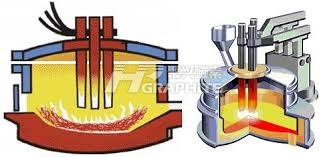Carbon material production technical problems & answers 3-- Ingredients

Carbon material production technical problems & answers 3-- Ingredients
I. What are the ingredients of carbon production?
1. Select the type of carbon raw materials;
2. Determine the proportion of different kinds of raw materials;
3. Determine the particle size composition of solid carbon raw materials;
4. Determine the softening point and dosage of the binder.
Juxing graphite electrode strictly monitors the production quality from raw materials to products, and unqualified products are directly eliminated, eliminating your worries.
II. How does the batching post achieve stable batching?
In order to ensure the stability of product proportioning particle size, on the one hand, it is necessary to regularly take samples from each storage hopper for screening analysis to check whether the proportioning purity fluctuates. If the fluctuation is too large, measures should be taken in time.
On the other hand, it is also necessary to regularly take various particle size materials from the storage hopper, screen and analyze them according to the percentage composition of the formula, and check whether they meet the technical requirements. If not meet the requirements, should stop batching immediately, update and adjust the formula, or discharge the unqualified materials until they meet the requirements, and then continue batching. It is necessary to regularly check the batching equipment to maintain the accuracy of batching, so as to avoid batching errors, The weighing must be carried out in strict accordance with the ingredient list, and it must be rapid and accurate. Do not exceed the specified error.

III. What is the function of binder?
1. It has good wettability and adhesion to carbon materials, thus ensuring good plasticity of the paste.
2. The binder should have high carbon content and coke yield.
3. The binder shall be a thermoplastic substance, which is a solid at room temperature, slightly heated and melted into a liquid, and immediately hardened after cooling.
4. Wide source and low price.
IV. What is kneading? What role does it play in carbon production?
The solid carbon raw material particles and powder are mixed with the binder at a certain temperature to form a plastic paste. This production process is called kneading. Kneading plays the following three roles in carbon production:
1. Mix all kinds of raw materials and fill particles of all sizes to form a mixture with high hardness.
2. It is easy to mix the material and the binder evenly. The liquid binder is evenly coated on the surface of the dry material particles, and all particles are bonded together by the adhesion of the binder, giving the paste plastic molding.
3. Make the adhesive partially penetrate into the pores of dry material particles, and further improve the binder property and the degree of compactness of the paste.
V. How to control the paste kneading temperature?
The most suitable kneading temperature of the paste depends on the softening point of the binder. Generally speaking, the kneading temperature should be 50 ~ 80ºC higher than the softening point of the binder. When using medium temperature asphalt, the kneading temperature should be kept within 115 ~ 150ºC, with about 130ºC being the most appropriate. Using modified asphalt, the kneading temperature is increased to 160 ~ 180ºC.
In the process of kneading, it is not allowed to reduce the kneading temperature below the specified value, otherwise the wettability of the binder to the aggregate particles and the fluidity of the paste will be reduced, making kneading difficult. Therefore, when the heating temperature is low, the kneading time should be extended, and the binder should be added after reaching the index. The kneading temperature also has a certain relationship with the climate. In winter, the temperature is low, and the heat dissipation is fast after the paste is out of the pot. Therefore, the kneading temperature in winter should be slightly than other seasons.
Ⅵ. What determines the kneading time?
1. When the kneading temperature is low, the kneading time can be appropriately extended; When the kneading temperature is high, the kneading time can be appropriately shortened.
2. Using the binder with low softening point can appropriately shorten the kneading time at the same kneading temperature.
3. The more powdery particles in the ingredients, the longer the kneading time should be.
4. The kneading time should be appropriately extended when adding green scraps.
5. When the kneading is stopped for some reason, it should be kept warm and the kneading time should be extended.
VII. What are the factors that affect the kneading quality?
1. Temperature;
2. Time;
3. Dry material properties;
4. Binder.
VIII. When there is too much coal tar pitch, why can't it be mixed with dry materials?
The amount of coal asphalt binder depends on the surface of carbon raw material particles and its adsorption capacity to asphalt. Adding a certain amount of asphalt as required can make the paste knead evenly and have good plasticity. In the kneading process, when the amount of dry material is too much, asphalt can be added for mixing, but if the amount of asphalt is too much, dry material cannot be added for adjustment. This is because the fluidity of the added dry matter particles is not as good as that of liquid asphalt, which can not be evenly distributed in the whole paste, but locally accumulated in the paste, resulting in the inclusion of dry matter and uneven quality of the whole paste. If you encounter problems in the use of graphite electrode, please contact us directly, and we will provide you with solutions in time.
No related results found








0 Replies